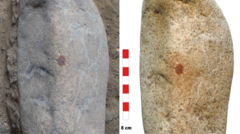In a remarkable archaeological find, scientists in Spain announced the discovery of the oldest full human fingerprint, suggesting that Neanderthals may have created art. The team excavated a rock at the San Lázaro rock shelter in Segovia, which features a dot made from red pigment, resembling a human face, and believed to date back around 43,000 years.
Researchers propose that a Neanderthal dipped their finger in the pigment to paint a nose on the stone. The "strategic positioning" of the red dot indicates potential symbolic behavior, reflecting an abstract thought process in Neanderthals. Co-author of the study, María de Andrés-Herrero, emphasized that these findings contribute significantly to the ongoing discourse about the artistic capabilities of Neanderthals.
The excavation at San Lázaro commenced five years ago, and the dot was uncovered beneath 1.5 meters (5 feet) of sediment associated with Neanderthal groups. In a conversation with BBC's Newsday, Prof. de Andrés-Herrero described their astonishment upon unveiling a larger stone with a conspicuously applied red dot, stimulating their initial queries.
After extensive analysis confirmed the presence of ochre pigment, researchers enlisted the help of Spain's scientific police to delve deeper into the case. Their efforts led to the identification of a fingerprint, reportedly from an adult male. However, archaeologist David Álvarez Alonso noted the lack of comparative Neanderthal references makes definitive conclusions challenging.
Gonzalo Santonja, a Spanish official, remarked at a news conference that this pebble stands as "the oldest portable object to be painted in Europe and the only known piece of portable art attributed to Neanderthals." Prof. de Andrés-Herrero described the finding as a pivotal contribution to understanding Neanderthal symbolic capacity, highlighting that the fingerprint was found in a context that suggests artistic intent.
Moreover, the presence of red pigment, which is not naturally found at the shelter, hints that Neanderthals brought it to the location and purposely altered the stone. Prof. Alonso speculated that a Neanderthal likely selected the rock for its fissures and intentionally marked it with ochre, indicating the importance of this discovery within archaeological discussions on Neanderthal behavior.
The researchers' findings were documented in the journal *Archaeological and Anthropological Sciences*, indicating that the given pebble possesses exceptional characteristics, which lead them to classify it as a potential visual symbol or piece of portable art, blurring the lines of our previous understanding of Neanderthal capabilities.
Researchers propose that a Neanderthal dipped their finger in the pigment to paint a nose on the stone. The "strategic positioning" of the red dot indicates potential symbolic behavior, reflecting an abstract thought process in Neanderthals. Co-author of the study, María de Andrés-Herrero, emphasized that these findings contribute significantly to the ongoing discourse about the artistic capabilities of Neanderthals.
The excavation at San Lázaro commenced five years ago, and the dot was uncovered beneath 1.5 meters (5 feet) of sediment associated with Neanderthal groups. In a conversation with BBC's Newsday, Prof. de Andrés-Herrero described their astonishment upon unveiling a larger stone with a conspicuously applied red dot, stimulating their initial queries.
After extensive analysis confirmed the presence of ochre pigment, researchers enlisted the help of Spain's scientific police to delve deeper into the case. Their efforts led to the identification of a fingerprint, reportedly from an adult male. However, archaeologist David Álvarez Alonso noted the lack of comparative Neanderthal references makes definitive conclusions challenging.
Gonzalo Santonja, a Spanish official, remarked at a news conference that this pebble stands as "the oldest portable object to be painted in Europe and the only known piece of portable art attributed to Neanderthals." Prof. de Andrés-Herrero described the finding as a pivotal contribution to understanding Neanderthal symbolic capacity, highlighting that the fingerprint was found in a context that suggests artistic intent.
Moreover, the presence of red pigment, which is not naturally found at the shelter, hints that Neanderthals brought it to the location and purposely altered the stone. Prof. Alonso speculated that a Neanderthal likely selected the rock for its fissures and intentionally marked it with ochre, indicating the importance of this discovery within archaeological discussions on Neanderthal behavior.
The researchers' findings were documented in the journal *Archaeological and Anthropological Sciences*, indicating that the given pebble possesses exceptional characteristics, which lead them to classify it as a potential visual symbol or piece of portable art, blurring the lines of our previous understanding of Neanderthal capabilities.



















